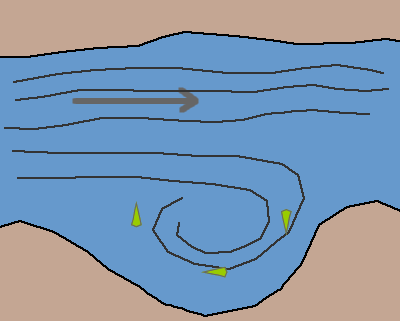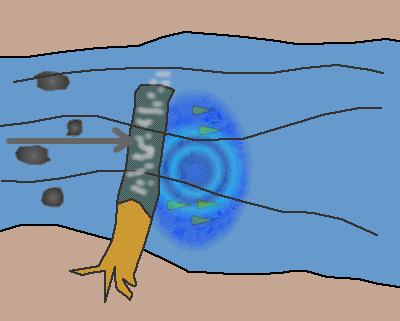

Types of Streams | |||
There are three types of streams generally identified within the Sierra Nevada:
| |||
Stream Profiles | |||
| |||
 | |||
Stream Structure | |||
Stream Structure is a function of Gradient, Type of bottom material, and Depth. These factors will determine whether the portion of the stream is a Riffle, Run, Pool, or Tail. These structures are found on all streams. On some streams, there are three other structures that might occur due to these factors: Flats, Rapids, and Cascades. | |||
Riffles | |||
Riffles are an excellent place to find trout, particularly in low light conditions. The stream is well oxygenated as the water flows over shallow depths of 3 feet or less with a bottom of hand-sized rocks and gravel. The bottom will have a layering of materials starting with the largest stones on the top, follwed by gravel, pebbles, sand, and silt. This layered effect causes the top stones to migrate downstream, often dislodging insects. Riffles will have a slight gradient and will become shallower as the gradient increases. This shallow water allows good photosynthesis for healthy plant growth. The white froth created by the turbulence provides protection to the trout by hiding underneath it, out of sight from preditors. This gives the flyfisherman a great opportunity to work close to the fish with short casts. Many insects live within this zone of stream due to the healthy plant growth, Caddis are particularly adapted to riffle water and are an important food source for the trout. Most of the trout feed on the nymphal stages. There are usually a good supply of mayflies emerging in the Spring and early Summer, wet flies or emergers will work well. Stoneflies will hatch during the late afternoon and evenings and provide a good dry fly opportunity. Fingerlings and Fry will find many places within the riffle to escape the current. Modest-sized stones will often provide resting places for trout in the 9-12" size class. A few larger rocks or boulders may reside within a riffle and these create very good Holding Lies for trout in the 12-16" size class. There is often a regular spacing of riffles within a stream, usually 5-7 stream widths apart. Each riffle has a top end that includes two small eddies at each corner, forming a triangle. This water is usually about 1-2 feet deep. It's rough water but not yet choppy. This front section of the riffle can be the best area to fish. If the riffle does not have many good holding lies within the main body, trout will often hold at the tail end of the riffle, waiting for the food to float down to them. Look for any obstructions within the riffle water, trout will often lie in front or behind them. Trenches can create a prime lie for the trout. Within a riffle, a trench can be formed by a base rock ledge, that can be seen by the surface water being somewhat calmer. Two currents of a riffle might come together, such as around an island. When these currents meet it causes a turbulence that will subdue the flow. These are known as current seams and can be good holding areas for trout. | |||
Runs | |||
Runs are usually deeper than riffle water, 3 to 6 feet, and do not have the characteristic white froth one finds in riffle water. The choppiness of the riffle above will often continue into the beginning of the run. It will also tend to be narrow at the head of the run, then, widen out. When runs occur on a curve of the stream, it will deepen on the outside and be shallow on the inside. .Runs will transcend into riffles or into a pool. The gradient is not steep but runs have a strong flow and are associated with undercut banks and deep channels. The bottom is usually sand with small boulders and uneven stones. Runs usually have larger trout than riffle water. Trout will often use the runs as a prime lie and make excursions into the riffles for food. Runs also provide more shelter from the current, since it is not as fast as within the riffle and the deeper water provides a slower current along the bottom. Runs that travel through bouldered areas can be a good source for trout since insect habitat will be numerous and the boulders provide good holding lies. Since the surface of the run is still distorted, the trout feel fairly protected unless they are high within the water column. Most insect activity occurs within depths of 2-4 feet, so runs can provide more insects than pools but not as many as a riffle provides. Insects tend to be larger in runs than riffles. Stoneflies, Mayflies, and Caddis can be found, in addition to Sculpins along the bottom. With a depth of 3-6 feet, the bottom of the run can be a place that is very protected to the trout and will also have a slower current than higher within the water column. In many runs, the bottom stratum can be gravelly and scoured by the current so that it is devoid of most forage to the trout and as well as resting sites. Trout will not be found within runs of this nature. These are known as "Barren Runs". If the depth of the run if 2-4 feet and the bottom is a homogenous with sand and embedded stones, then the run will often be a "Holding Run. Food will not be prolific within this type of run and most of the trout will be smaller than average for the stream. The "Prime Runs" are 2-6 feet deep with various boulders and mixed sizes of stones. There will be layer of algea growth on the rocks providing a good food source for insects. There will also be larger boulders providing a home for crayfish and baitfish. Big trout reside in Prime Runs. Like a riffle, the corners at the head of a run can be the best lie for a trout. If the head has a slow current with gentle eddies, trout will hold there. If the head of the run starts with a shelf, 4-6 feet deep, this will be a prime lie and the largest trout of the stream will reside there. Look for signs of a trench along runs, these will appear as slightly darker water on the surface. Trout will utilize these trenches for holding lies. Current seams can also exist within runs where two currents come together and create turbulence. Trout will hold along this seam. The tailout of a run will become shallow from the buildup of gravel yet rich with insect activity. Wet flies work well within this stretch of the run. | |||
Pools | |||
|
Pools are havens for trout to escape the currents and hide within the depths from preditors. The largest fish of a stream are often found within pools. They occur when the streambed dips and then rises again. It is the deepest part of any stream and will have the slowest current. The bottom contains fine sediments such as silt. The surface will be smooth. Pools contain the scavengers of the stream such as crayfish and midges that feed upon the organic matter that gets deposited within the pools. There are few insects within a pool. Most of the insect activity will be found at the head of the pool where it is shallower or the insect drift from the riffle or run above it. If the depth is sufficient, trout will consider the head of the pool to be a "Prime Lie", since the current is delivering food and protection of depth is available. In higher elevations, pools will form where the bedrock has been eroded and there is a lack of loose stones to fill it up. At lower elevations, pools will often have larger boulders and rocks within it's depths. These provide excellent protection for larger trout. Pools will also provide better protection from the currents that increase during the Spring runoff. The depth and darkness protect the trout from preditors such as Osprey. As water temperatures increase, pools will have less available oxygen than other parts of the stream but the depth helps alleviate this with cooler temperatures. Some pools will be developed by underwater springs which will also benefit the oxygen requirements of the trout. Dave Hughes (Reading the Water) identified 6 types of pools:
|
|||
Tails | |||
Tails are at the ends of pools where the water rises up from the depths and gets channelled into a more confined area. Usually there are large rocks and boulders within a tail that provides protection to the trout and the funneling effect of the the tail will concentrate the food flow through this area. Having the deeper pool nearby is also some comfort to the trout as a means of escape. Tailouts are generally feeding lies since there is little protection and shelter. When the tailout has a slow enough current, algea will form and create an excellent insect habitat that the trouit take advantage of. Usually the trout within the tailout of a pool is less than the average size, except during low light conditions. | |||
Flats | |||
Not every stream will have flats but you will encounter them often. Flats are usually less than 4 feet in depth and will have a gradient less than that of a riffle. The bottom wil consist of sand, gravel, and silt. You will usually find a good growth of weedbeds as well. There tend to be more productive flats on Spring Creeks than Freestone streams due to the lack of Winter or Spring run-off that will scour the bottom of weeds. Freestone streams may have flats but these are relatively unproductive, particularly if they are only 1-2 feet deep. Freestone flats will also get high water temperatures during the Summer which reduces available oxygen. Spring Creeks tend to maintain cool temperatures. Weedbeds will provide a shelter from the current and some protection from preditors. Caddis are very common within flats, as well as mayflies. On the Eastside Sierras, flats will often have scuds among the weeds. The weedbeds make it difficult to fish and demand short casts. Obstructions in flats tend to be logs since the current can't dislodge them. Look for trenches and ledges since these are common on flats. Trout will key into the insect hatches, so "match the hatch" is very important. | |||
Rapids | |||
Rapids are portions of the stream with a steep gradient. The bottom is quite rocky with large boulders and ledges creating a white frothy surface. Many relate to this structure as "pocket water" since there are pockets or eddies behind numerous obstructions that allow the trout to rest or hold. Pocket water can be difficult to fish due to the eddies that are formed. This means that nymph flies must get down deep very rapidly. Rapids have excellent protection from preditors as the surface is quite broken. Shelter from the current can only be found behind large boulders. The available oxygen is excellent within a rapid. Many insects will emerge from the pocket water such as Caddis and Stonelfies. This is usually excellent stonefly water for both Golden Stones and Salmonflies. The size of the trout that utilize pocket water is usually proportional to the size of the pocket. If you can get a dry fly to float within a pocket for 1-2 feet, then it is large enough for trout. | |||
Cascades | |||
When Rapids are strung together, they form a Cascade. These areas have a current that is too strong for the trout to stay and survive. Trout will struggle to move through these areas in search of better holding areas. | |||
Special Structures | |||
Boulders | |||
 Boulders make great resting spots for trout in a stream. The current will smack up against the face of the boulder and fall back upon itself creating a pillow in front of the boulder. This pillow area can become almost still as far as current is concerned. Often the largest trout will like to lie in front of the boulder taking advantage of this pillow effect and getting first pick at the food source. Behind the boulder, trout will also lie taking advantage of the eddies that are created as the current moves around the boulder and seeks to rejoin the midstream pathway behind the obstacle. Scour holes will form behind the boulders and will offer additional refuge to the trout. Food is also concentrated within boulder eddies and pillows as the material gets trapped within this zone and the trout take advantage of this. | |||
Back Eddies | |||
 Back Eddies are special structures to a stream. They occur when the stream meets an obstruction such as as rock, log, or protruding bank, that causes the current to turn back on itself. The current will often swirl leaving a dead area in which foam and debris get trapped. This can be a good area to find fish. Try a slack line cast, such as a puddle cast to provide enough slack line to get a drag-free drift within the eddie. | |||
Drop-Offs | |||
 Drop-offs occur where there is an underwater ledge, such as a sunken tree or rock formation, that forces the water to drop into a deep hole. The deep hole can be seen as a darker area within the stream and there are often some wave actions occuring over the drop-off structure. A zone of calm water will form just behind the drop-off and trout will tend to lie in these areas. This zone will give the trout an easy place to hide without effort and food will flow to them. These structures are perfect locations for dead-drift nymphing. Just prior to a hatch, more nymphs and pupa will be carried into the zone and you might see the flashing of the trout within the deep pool. During the hatch, the trout will spread out to either side of the drop-off. | |||
Banks | |||
Along the banks of streams there are indentations that provide shelter from the current. If there is sufficient depth, trout will use banks as good holding lies. Lots of insect activity occurs along banks and the trout will hold along the banks waiting for food to drift to them. Caddis and stoneflies emerge during the Spring, Caddis and Hoppers will be fouind in the Summer, and Caddis will also be there in the Fall. Streams that have constant flows such as Spring Creeks and Meadow Streams have excellent banks. Streams that experience high runoff during the Spring and low flows during the Summer months will have poor banks. Some Freestone streams will have good banks on the outside of bends. The best banks are those that have a natural rocky edge on streams with fast currents. Riffles rarely have productive banks but runs, pools, and flats often have good ones. Look for a bank that has a good current, provides shelter, and has sufficient depth for protection. | |||